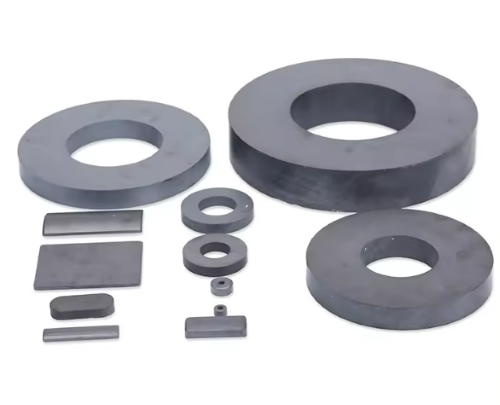How to Choose Permanent Magnet Materials
Factors Affecting Permanent Magnet Materials
Selecting the right permanent magnet material is crucial for the success of your application. Here are the key factors to consider when choosing permanent magnet materials:
1. Magnetic Strength:

- Neodymium (NdFeB) magnets are the most powerful magnets, known as the "king of magnets," with a (BH)max of up to 52 MGOe.
- Samarium Cobalt (SmCo) magnets have a (BH)max of about 26 MGOe. They are easier to process into special shapes and are ideal for high-temperature applications.
- Alnico magnets have a (BH)max of 5.4 MGOe. They are useful for applications requiring stability over a wide temperature range and good mechanical strength.
- Ferrite magnets have the weakest magnetic force with a (BH)max of 3.6 MGOe. They are cost-effective for applications where high magnetic strength is not essential.
1. Temperature Stability:
Choosing Permanent Magnets Based on Operating Temperature
- Up to 500°C: Choose Alnico magnets for their ability to withstand temperatures up to 500°C.
- 250°C to 350°C: SmCo magnets are ideal for this range.
- Below 300°C: Ferrite magnets are suitable, with an upper limit of 300°C.
- 80°C to 230°C: NdFeB magnets are recommended for their strong magnetic force within this range.
Related reading: List of Magnets That Can Withstand High Temperatures
2. Corrosion Resistance:
- SmCo and Ferrite: These materials are naturally corrosion-resistant.
- NdFeB: These magnets are susceptible to corrosion and often require protective coatings such as nickel or Teflon.
- Alnico: These magnets have good corrosion resistance but can oxidize if not protected.
To prolong the lifespan and performance of your magnets, we provide various surface coating treatments, including nickel, epoxy, and PTFE coatings. These coatings enhance corrosion resistance, ensuring durability and reliable performance in harsh environments.
Related reading: Types of Neodymium Magnet Coatings: Protecting the World's Strongest Magnets
4. Mechanical Strength:
- NdFeB and SmCo: Brittle and can break under mechanical stress; need to be handled with care.
- Ferrite: Brittle but can be used in rugged environments due to its low cost.
- Alnico: Excellent mechanical strength and machinability.
5. Cost:

--Ferrite Magnet:
Ferrite magnets are the most cost-effective due to their relatively cheap raw materials. This makes them ideal for large-scale production where high strength is not essential. They have a large market demand and are commonly used in handbag factories, speaker factories, and leather goods factories.
--NdFeB Magnet:
Neodymium (NdFeB) magnets, though higher in cost due to the use of rare earth elements, offer superior strength and are highly cost-effective. They have the highest output value despite not matching the annual production volume of ferrite magnets. NdFeB magnets are widely used in magnetic connectors, DC motors, robots, smart homes, and various other fields.
--Alnico Magnet:
Alnico magnets, developed from an alloy composed of aluminum, nickel, cobalt, iron, and other trace metals, are relatively expensive. They are known for their temperature stability and machinability. Alnico magnets are primarily used in motors, microphones, sensors, speakers, and traveling wave tubes.
--SmCo Magnet:
Samarium Cobalt (SmCo) magnets are made from samarium, cobalt, and other rare earth metals. The production process involves mixing, melting, refining into alloy, grinding, pressing, and sintering, which makes them very expensive. SmCo magnets are mostly used in high-end permanent magnet motors due to their excellent temperature stability and performance in demanding environments.
How to Choose Permanent Magnet Materials
Table 1. How to Choose Permanent Magnet Materials
|
Magnetic Strength |
Highest, (BH)max up to 52 MGOe |
Moderate, (BH)max about 26 MGOe |
Lower, (BH)max 5.4 MGOe |
Weakest, (BH)max 3.6 MGOe |
|
Temperature Stability |
80°C to 230°C |
250°C to 350°C |
Up to 500°C |
Below 300°C |
|
Corrosion Resistance |
Requires protective coatings (nickel, Teflon) |
Naturally corrosion-resistant |
Good, but can oxidize if not protected |
Naturally corrosion-resistant |
|
Mechanical Strength |
Brittle, handle with care |
Brittle, handle with care |
Excellent mechanical strength, machinable |
Brittle, but cost-effective for rugged use |
|
Cost |
Higher cost |
Very expensive |
Relatively expensive |
The most cost-effective, large market demand |
|
Common Applications |
Magnetic connectors, DC motors, robots, smart homes |
High-end permanent magnet motors |
Motors, microphones, sensors, speakers |
Handbag factories, speaker factories, leather goods factories |
Related reading: How to Choose a Permanent Magnet?
Conclusion:
Choosing the right permanent magnet material involves balancing magnetic strength, temperature stability, corrosion resistance, mechanical strength, cost, specific application requirements, and suitable surface coating treatments. By carefully considering these factors, you can select the most suitable magnet material to ensure optimal performance and longevity for your application. For more information, please check Stanford Magnets.












